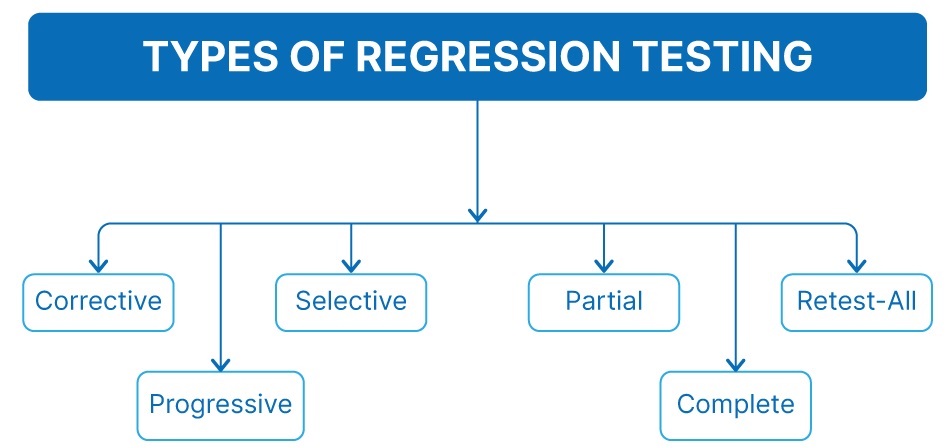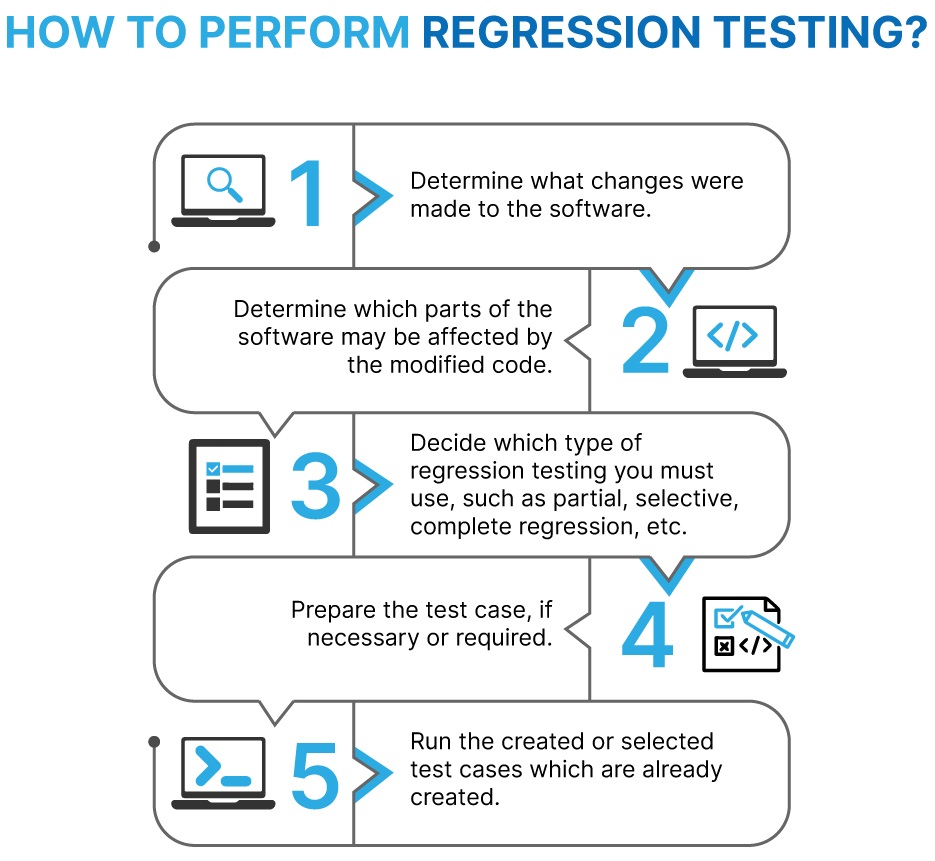Regression Testing – All That You Need To Know
Even minor changes can have disastrous results when software developers change or modify their code. As a result, testing, or in particular Regression Testing, becomes essential because a buggy application with different functionalities can cost you money and a user base.
The next question that may have come to your mind is: What is Regression Testing? Without wasting any further time, let’s explore the definition of regression testing in order to resolve this query.
You can also explore these articles:



Regression Testing Definition: Regression testing is a type of software testing that tests software when it undergoes a code change to ensure that new code has not affected other parts of the software.
In layman’s words, regression testing is done to ensure that an application continues to work as anticipated after any updates, code changes, or improvements.
You can also explore: Functional testing and its types
Before moving any further, let’s go through the topics listed under the table of content (TOC) that we will cover in this article.
Table of content (TOC)
- Regression Testing Example
- Types of Regression Testing
- Regression Testing Tools
- When to Perform Regression Testing?
- How to Perform Regression Testing?
- Advantages of Regression Testing
- Disadvantages of Regression Testing
- Conclusion
Regression Testing Example
In order to understand how a typical regression testing scenario works in a better way, let’s go through an example.
Assume you are the owner of a software development firm. One of your clients has asked you to create a social media platform where strangers can log in, connect, and communicate. After some time, you performed various types of software testing, totaling 100 test cases, before presenting the software to the client. The client was pleased with the software, but he recommended the addition of a video call feature.
Your team began working on the request, and the development team eventually implemented the video calling feature. But, before presenting the software to the client, you must ensure that the new functionality works properly. So, you put it through 50 new test cases.
After running those 50 new test cases, you must ensure that none of the old functionalities have been impacted by the new feature. So you decided to perform regression test, which involves running the 100 previous test cases to ensure that essential functions have not been impacted.
You can also explore these articles:



Best-suited Quality Assurance & Testing courses for you
Learn Quality Assurance & Testing with these high-rated online courses
Types of Regression Testing
There are six main types of regression testing, such as:
Let’s explore each of them:
Corrective: Corrective performance testing is used to determine whether or not the current system is functioning correctly. There is no need to write new test cases in this type of testing as the old test cases are used to validate the software’s existing functionalities.
Progressive: Progressive testing checks the software after changes are made to its specifications or components. Because old test cases are no longer applicable in this case, new test cases are required.
Selective: Selective testing aims to check selected specifications or components of software using selected test cases from a list of existing tests. In this type of testing, no new test cases are created.
Partial testing: Partial testing examines the functionality of a module created by combining two different modules. It ensures that the new module’s functionalities work in tandem with the old ones. New test cases are required to validate the new functionality.
Complete testing: Complete testing aims to test the entire system at once. This testing helps to validate software in situations such as implementing large-scale updates, root code updates, etc. This type of testing necessitates the creation of new test cases in order to test the software thoroughly.
Retest testing: Retest testing aims to retest all types of regression tests performed up to this point. This testing is performed when there is a suspicion that something was missed or not done correctly during the previous testing stages. As a result, retesting everything from scratch becomes more effective than attempting to identify what went wrong previously. This type of testing, in typical situations, does not require new test cases because testers can use old test cases to validate the software.
You can also explore, these articles:



Regression Testing Tools
Let’s explore the top 5 regression testing tools, such as:
Apache JMeter: This is an open-source regression test automation tool in Java. JMeter’s core features include the capability to conduct load and performance tests, provide an end-user regression test suite, and measure service performance.
Katalon Studio: This is an all-in-one regression tool for your web services and, website, mobile application. The tool also allows scripts to run on various devices, web browsers, and environments.
Watir: This is an open-source library written in Ruby language that allows you to write tests that are simple to read and maintain using a lightweight and adaptable user interface.
Subject7: This is a popular cloud-based regression tool for computer, web, and mobile apps. The tool is available for public, private, and hybrid cloud-ready apps and supports high-scale parallel execution.
Selenium: This excellent regression tool generates automated test scripts based on datasets and is perfect for large-scale quality assurance tests with skilled testers.
When to Perform Regression Testing?
You should perform regression test in situations such as:
- When an existing feature is given a new requirement
- Whenever a new feature is added, or the code base is updated to fix bugs
- Once the source code is optimized for better performance
- When configuration changes have been made, or patch fixes have been added
How to Perform Regression Testing?
Regression testing can be complex if not done using suitable tools and in the correct order. You can perform regression test using the steps shown below in the image:
- Determine what changes were made to the software.
- Determine which parts of the software may be affected by the modified code.
- Decide which type of regression test you must use, such as partial, selective, complete regression, etc.
- Prepare the test case, if necessary or required.
- Run the created or selected test cases which are already created.
Here’s a graphical representation:
Advantages of Regression Testing
Here are some of the advantages of performing regression test:
- Serves as a risk-mitigation strategy during testing
- Improves application quality, and this testing can be automated
- Ensure that previously resolved problems and flaws (bugs) are not repeated.
- Involves checking for code modifications to make sure they do not have an adverse effect on other features.
Disadvantages of Regression Testing
Here are some of the disadvantages of performing regression test:
- It could be a time-consuming task and quite expensive
- It must be done for any minor changes to the software code.
- The test cases required to perform regression test can be complicated at times.
- Regression test should be performed at least once during an agile sprint.
Conclusion
Regression testing checks whether the software continues to work as anticipated after implementing a new feature, requirement, code, etc.
This type of testing can be tedious as it must be performed after each change in the software code. Whether the change implemented is minor or significant doesn’t matter. This makes this type of testing quite complex, time-consuming, and expensive.
Even after all this, regression test is one of the most important types of software test. Even a very minute change can have disastrous results, such as after updating the code for the login button, the user might not be able to log out of the software. Hence, this testing is quite essential and can’t be missed.

Anshuman Singh is an accomplished content writer with over three years of experience specializing in cybersecurity, cloud computing, networking, and software testing. Known for his clear, concise, and informative wr... Read Full Bio



